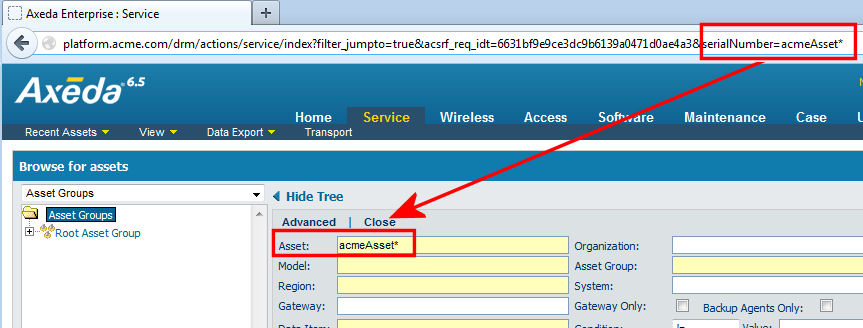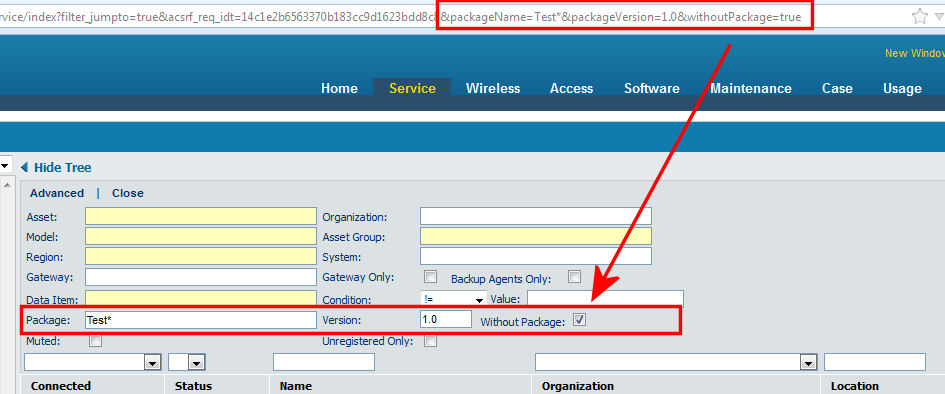
You can configure custom applications to “jump” the user and his credentials to the Service Application, Asset dashboard page. To do this, the custom application needs to specify a URL that provides the filter_jumpto=true attribute (rather than the default filter_preserve=true). Also the URL needs to provide a valid CSRF token and Session token (session tokens are explained below).
In the following example:
http://platform.acme.com/drm/actions/service/index?filter_jumpto=true&acsrf_req_idt=7dee1cfdaf059fdc814bb3ee94e838a4&serialNumber=acmeAsset*
o filter_jumpto is set to true
o a valid CSRF token (acsrf_req_id) is specified.
o a search filter (serialNumber) is set to search for all assets to the user has permissions and that start with "acmeAsset".
For the above custom application URL, to Platform will "jump" the user to the Asset dashboard with asset search as shown below:

The Asset dashboard will display only if the user has the appropriate privileges. In addition, only the assets to which the user has privileges will be accessible.
A custom application can provide one or more session tokens for Asset dashboard jump-in searches. Each URL can specify multiple session tokens, which are appended to the URL and linked by "&".
Jump-in tokens are provided for Asset Dashboard search fields as follows:
| Search Field | URL Parameter | Argument |
Asset |
serialNumber=Test* |
String |
Model |
modelName=Test* |
String |
Region |
regionName=Test* |
String |
Organization |
Company=Test* |
String |
Asset Group |
deviceGroupName=Test* |
String |
Data Item |
dataItemName=Test*&dataItemValue=Foo*&dataItemCondition=1 |
String, String, Enumeration |
Gateway Only |
gateway=true |
Boolean |
Never Registered |
neverRegistered=true |
Boolean |
Backup Agents Only |
forBackupAgentsOnly=true |
Boolean |
Muted Assets Only |
muted=true |
Boolean |
Device Status |
deviceStatus=1 |
Enumeration |
Package |
packageName=Test*&packageVersion=1.0&withoutPackage=true |
String, String, Boolean |
Note: The URL parameter value will be case-sensitive. For example, use deviceStatus not DeviceStatus or devicestatus.
As shown above, dataItemCondition and deviceStatus parameters take enumerations which represent supported data item conditions and device statuses in the Platform, respectively.
When including Data Item Conditions or Device Status in custom application URLs, use the following enumerations:
| DataItemCondition | DeviceStatus | ||
| Enumeration | Value | Enumeration | Value |
1 |
has |
1 |
Missing |
8 |
!= |
2 |
Online |
9 |
<= |
3 |
Muted |
10 |
>= |
|
|
11 |
== |
|
|
12 |
< |
|
|
13 |
> |
|
|
16 |
matches |
|
|
For example, the URL parameters "packageName=Test*&packageVersion=1.0&withoutPackage=true" will display the Asset dashboard with search values predefined with values to search for assets with packages named Test* of version 1.0, as shown below:
